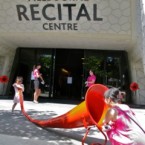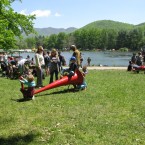Sydney Opera House
Forecourt January 2009
Attendants: Sally Smith, David Wells, Sam McGilp, Jesse Stevens, Merophie Carr, Eliana Horn, Madeleine Flynn and Tim Humphrey.
Listening at the Harbourside
This is an extraordinary site.
As an internationally renowned icon, the Sydney Opera House draws people who wish to experience the space, and who are familiar with the image and shapes of the Opera House from visual material.
Our observation is that people who are coming to the Opera House forecourt are often coming for the first time: they come to see the iconic building, and have made a particular effort to come here.
Once they are here, they wander, they sit, they observe. As such, they are particularly open to interaction- they come with a desire to see an imagined place- the real version of something that has only existed in their imagination. This seems to place people in a very open position: they come with a willingness to engage.
As an interactive work, this made the megaphone project ideally placed to work with people who come to the Forecourt.
Calling Connections
The particular emotional engagement of the space allowed people to interact across the field- with their companions, and also interestingly with others who were unknown to them. For example, we heard many conversations across the field between people who didn’t know each other.
The international crowd that comes to the Forecourt brings with it an incredible array of language and song: Farsi, Malay, Mandarin of course, Japanese, Korean, Arabic from home and abroad, Texan, Queenslandic and the Cook Islands.
We estimate that 1000 people a day engaged with the megaphone project in some way.
Wireless Babel
This install reached a new point in our technological progress, with the implementation of ten Eepc 901 computers, linked wirelessly and sending audio streams around the megaphone field. At different times the piece worked in its most developed sense as an audio work as snippets of call, chopped and distorted voices in many languages of all ages merged in a beautifully-ambiguous electro-acoustic and acoustic surround soundfield.
The tweaking of levels, both acoustic and electronic was something that could only happen in the moment of the field. Integrating this into a performance and interactive event is one of the more pleasurable quirks of the project as the mystery of “technology” and the artistic magic of the “technician” blended to create a kooky abstraction that echoes literally and metaphorically the private and public communication fetishes of the modern world.
Pleasures of Performance
Favourite moments includedthe traditional song from the group of students from Sabah, the exceptional performers of songs from Chinese operas, and the group of six indigenous siblings from Kalgoorlie, who ended up playing and trading sound with another group of siblings from Germany.More poignant moments involved mothers, fathers, sons and daughters, discovering the pleasures of a focused public communication. As ever grandma and grandpa were far more likely to lie on the ground with the grandchildren than their sons and daughters! In terms of the performance/attendant role, the ritualized change of shift and handover event emerged as a new development. Our team of eight, ranging across all decades from teens to 50s, each brought an individual style of interaction with the audience.
This project would not have been possible without the support and insight of Dennis Watkins and his team, Jaslyn Hall, Georgia Hendy, Tristan Taylor, Roxanne Smith and Joy Pereira. Special thanks also to Arthur for tending to the curly horn in its hour of need. And to our incredible team, a deep thankyou for travelling with us, and showing us the way to make it happen.













